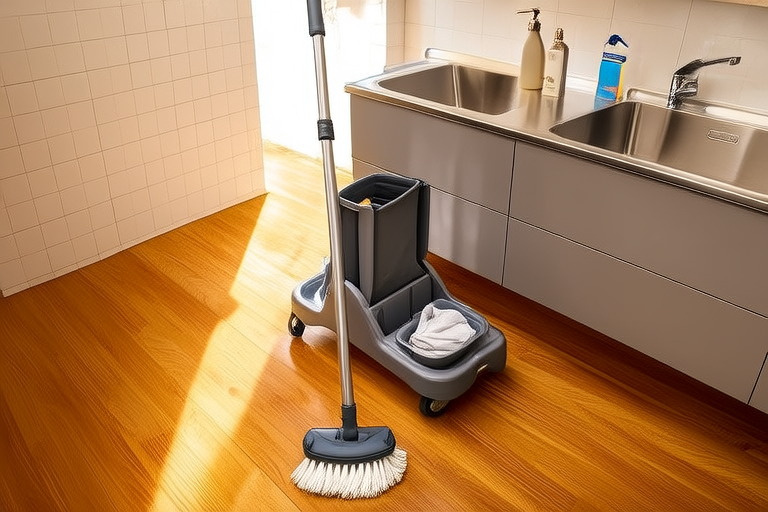Mastering the Art of Deep Cleaning Hardwood Floors and Other Surfaces
Introduction
Maintaining the beauty and longevity of your hardwood floors and other surfaces is not just about aesthetics; it’s also about preserving the value of your home. Proper cleaning techniques can prevent scratches, stains, and wear, ensuring that your surfaces remain pristine for years to come. Whether you’re a homeowner or a landlord, mastering the art of deep cleaning these surfaces is essential. In this article, we’ll explore effective methods to clean hardwood floors and other surfaces thoroughly, offering practical tips and step-by-step instructions to help you achieve a spotless finish.
Understanding the Basics of Hardwood Floor Care
Before diving into the deep cleaning process, it’s crucial to understand the basics of hardwood floor care. Hardwood floors are sensitive and require gentle yet thorough maintenance to avoid damage. Regular sweeping and dust mopping are the first lines of defense against dirt and debris. Sweeping with a soft-bristled broom or using a microfiber mop can prevent scratches and keep your floors looking fresh between deeper cleans.
The Importance of Proper Preparation
Proper preparation is key to successful deep cleaning. Start by removing all furniture from the room or at least moving it to the center. This ensures that you have full access to every part of the floor. Next, vacuum or sweep the entire area to remove any loose dirt or debris. For more stubborn particles, use a dry mop designed for hardwood floors to lift away grit without scratching the surface.
Choosing the Right Cleaning Products
Selecting the right cleaning products is critical for effective deep cleaning. Not all cleaners are created equal, and using harsh chemicals can damage your floors. Opt for pH-neutral or specialized hardwood floor cleaners that are specifically formulated to protect and enhance the natural beauty of your wood. Avoid using vinegar, bleach, or ammonia-based cleaners, as they can strip the finish and cause discoloration.
Natural Alternatives for Greener Cleaning
If you prefer eco-friendly options, there are several natural alternatives that can be just as effective. A mixture of warm water and mild dish soap works wonders for general cleaning. For tougher stains, consider using a solution of baking soda and water to scrub gently. Always test any new cleaning method on a small, inconspicuous area first to ensure it doesn’t cause damage.
Step-by-Step Guide to Deep Cleaning Hardwood Floors
Deep cleaning your hardwood floors requires a systematic approach to ensure every inch is treated properly. Follow these steps to achieve a spotless finish:
- Preparation: As mentioned earlier, start by clearing the room and removing any loose dirt.
- Application of Cleaner: Apply a small amount of hardwood floor cleaner to the mop head or a soft cloth. Use enough cleaner to dampen the mop or cloth but not so much that it drips.
- Mopping Technique: Mop in sections, starting from one corner and working your way across the room. Overlap each pass slightly to ensure even coverage. Pay extra attention to high-traffic areas and corners where dirt tends to accumulate.
- Drying: Once the floor is mopped, allow it to air dry naturally. Avoid using fans or heaters, as they can cause the floor to warp or crack.
- Polishing (Optional): If desired, apply a wood polish or wax to enhance shine and protect the surface further. Be sure to follow the manufacturer’s instructions carefully.
Extending the Guide to Other Surfaces
While hardwood floors require special attention, many of the principles discussed here can be applied to other surfaces as well. For instance, tile and laminate flooring can benefit from similar preparation and cleaning techniques. The key is to choose the right tools and products suited to the specific material.
Special Considerations for Different Surfaces
- Tile Floors: Tile is generally more durable than hardwood, but it still benefits from regular cleaning. Use a pH-neutral cleaner and a microfiber mop for best results. Avoid abrasive scrubbers that could scratch the surface.
- Laminate Floors: Laminate flooring is less porous than hardwood, making it easier to clean. However, it is susceptible to water damage, so use a damp mop rather than soaking the floor.
- Ceramic Tiles: Ceramic tiles are often found in kitchens and bathrooms. Clean them with a solution of water and a mild detergent, being careful not to let the water sit too long.
Practical Tips and Real-Life Examples
To make the deep cleaning process more manageable, consider implementing these practical tips:
- Routine Maintenance: Regular light cleaning can prevent the need for deep cleaning sessions. Aim to sweep or vacuum your floors at least once a week.
- Protective Measures: Place door mats at entrances to trap dirt before it reaches your floors. Use felt pads under furniture legs to prevent scratches.
- Professional Help: If you find deep cleaning overwhelming, consider hiring a professional cleaning service. They have the expertise and equipment to tackle tough stains and maintain your floors’ appearance.
Conclusion
In conclusion, mastering the art of deep cleaning hardwood floors and other surfaces involves understanding the materials, choosing the right products, and following proper techniques. By incorporating routine maintenance and protective measures, you can extend the life of your floors and keep them looking their best. Remember, a little effort now can save you time and money in the long run. So, take the time to learn these techniques and enjoy the satisfaction of having beautifully maintained floors in your home.
Actionable Steps
- Start with preparation: Clear the room and remove loose dirt.
- Choose the right products: Use pH-neutral cleaners and avoid harsh chemicals.
- Follow a systematic approach: Mop in sections and overlap passes for even coverage.
- Consider professional help: If needed, hire a cleaning service for tough stains.
